There’s no better time to chase blackfish from the rocks and here are some traditional and newer methods to tackle them.
SECTION:
MAPS:
Facts
ILLUSTRATIONS: 0
BREAK-OUT QUOTE: “They’ll even venture into water that hardly covers their backs if there’s a good chance of grabbing a bite to eat, especially after dark.”
Blackfish, or luderick, are popular rock-fishing targets and quite abundant in comparison to a lot of other species.
At times they can be easy to catch but, more often than not, you’ll need a few tricks up your sleeve to enjoy consistent success with these striped wonders.
Although the traditional method of drifting green weed or cabbage baits under a float is probably the best approach, there are a number of alternatives which will bring good results at times.
The truth is, blackfish eat a lot more than just green marine algae. A large percentage of their diet is made up of various types of brown-coloured weed as well as a number of other marine organisms.
From an angling perspective, they will also scoff down baits such as bread, prawns and pink nippers. Just to prove a point, I recently caught one on a Pascal marshmallow, so they are a fish that’s open to suggestion.
Before trying out different techniques or types of bait, it’s important to understand what sort of rock spots to look for if blackfish are the target.
Firstly, water depth isn’t much of an issue and, overall, these fish tend to prefer depths between 1m and 4m. They’ll even venture into water that hardly covers their backs if there’s a good chance of grabbing a bite to eat, especially after dark.
Most good blackfish spots have a reasonable degree of green cabbage or weed growth on rocks that are well exposed to the sun at low tide. Weed doesn’t flourish without sea water so most good blackfish spots are also low to the water, rather than high and dry ledges.
There are however, exceptions. Some of my favourite blackfish spots on the Central Coast are high, dry and very safe to fish from. Importantly, these ledges are surrounded by lower, wave-lashed rocks that do support healthy weed growth.
Sandy areas that are dotted with patches of reef a bit further out from the main rock ledge are also good for blackfish. A decent pair of polarised sunglasses enables us to see these patches of reef much easier and sometimes it’s possible to see blackfish swarming over such reef.
Fishing is generally better with some wave action and whitewash around the rocks but, obviously, safety is important when rock fishing.
A light 3m rod matched to a small threadline or Alvey blackfish reel is generally the best type of outfit to use.
Although I’ve heard of some anglers who prefer to use braid for blackfish, I firmly believe that nylon mono is the best way to go.
In fact there are specialist float-fishing lines available for this style of angling. I use is 5kg Sunline Fine Float line, which is bright yellow so it’s easy to see.
This line floats on the water and that makes hooking a fish much easier than if the line were to sink, creating a belly or sag in the water.
The tackle kit consists of a few different floats, rubber float stoppers, small plastic beads, some small black swivels, small ball, bean or barrel sinkers, split shot sinkers, some No 6 and No 8 hooks and a spool of trace line. That may seem a lot, but most of these items are very small and the lot can easily fit into a small tackle box.
Fixed stem floats, running stem floats and small bobby floats all work, although in most cases I like to use a running stem float.
The larger the float, the more sinker weight it will support and regardless of the type of float used, it should be weighted so that it bobs under the surface easily, rather than stays on top all the time. That way, when a fish bites the float will go under without the fish feeling much resistance.
Over the years I’ve tried many different types of line as traces for blackfish off the rocks.
Two types have well and truly proven to be the best. In nylon mono, 3kg or 4kg Maxima Green is abrasion resistant and tough and in fluorocarbon, 4kg Sunline FC Rock is durable and practically invisible – a big asset in clear water.
As for hooks, over 20 years of experience suggest that the Mustad 4190 is the pattern to go for.
Green cabbage is generally more abundant than green weed, but another type of brown, fluffy-looking weed is also a top bait. The brown stuff may be a bit more difficult to keep on the hook but if the fish are there they won’t refuse it.
In any case, weed or cabbage baits should be kept small, about the size of your thumbnail or slightly larger.
Providing the blackfish are present, in a co operative mood and you’ve rigged up properly, the time to strike is when the float quickly darts away into the depths. Sometimes the fish will muck around with the bait and the float will draw down a bit, then pop back up. If that’s the case, perhaps changing to a longer fluorocarbon trace, adding a bit more sinker weight or swapping to a smaller hook could result in more enthusiastic bites.
Both bread baits and pink nippers can be used on the same type of rig. The only change should be to go up a hook size to a No 6 or No 4 for bread baits or a No 4 or a No 2 for pink nippers.
The Mustad 4190 is still a good hook for these baits, although a baitholder or octopus pattern could be used.
Blackfish bite better on baits of plain white bread when some bread is also used as berley to entice the fish to bite.
A few loaves should be mashed to a pulp in some seawater, either in a bucket or in a small pool right next to where you are fishing.
The main reason a bucket can be good is to stop annoying seagulls or crows munching out on the berley and they can be extremely determined to get to it, especially the sneaky crows!
Go easy on the berley, only a handful every five to 10 minutes is plenty. Normally the best bet is to throw it in close rather than out far, but it depends on the exact location, current and sea conditions.
If you notice a few fish starting to smash bits of bread on the surface, simply adjust the rig so that the bait will be suspended up closer to the surface.
Pink nippers are also highly effective when ‘potholing’ after dark. Of course, fishing the rocks after dark should be done with caution and only at spots you’re familiar with.
The places to look for are small shallow pools that have some sort of access to deeper water. As the tide rises, fish may move into these pools to feed after dark, before retreating back into deeper water as the tide falls.
A good sign of a pool worth fishing is very short weed or cabbage growth. This indicates that blackfish have previously been feeding there.
If you’ve tried everything else, I can highly recommend fly fishing for surface-feeding blackfish.
Through late Summer and Autumn, blackfish congregate under scum lines just under the surface. Sometimes they may be well out of casting range but can be enticed closer in with some bread berley.
Flies tied to look like a piece of floating bread will certainly attract the attention of surface-feeding blackfish but they’re still not easy fish to fool.
I use a 6-weight rod, floating fly line and No 6 hooks tied with a white synthetic material called Egg Yarn.
At first, these flies sit on the surface, but after a few casts they very slowly sink.
With a floating line, though, they tend to remain in sight, only just under the surface.
It’s hard to keep track of a small white fly in the water but you need to see exactly when a fish takes it so you can strike back at the right time.
Polarised sunglasses are essential for this form of fishing so you can see as far below the surface as possible without any reflected glare.
It’s a very challenging way to fish, but a whole lot of fun at the same time.
Facts
SAFETY FIRST
Always study a spot you’re thinking about fishing for at least five minutes before venturing down onto the rocks. It may look fine at first, but wait until a few larger waves roll in before making any judgement. If in doubt, start looking for a safer, dryer ledge.
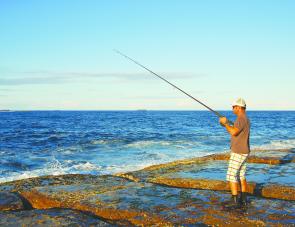
A light 3m to 3.6m with a small threadline or Alvey Blackfish reel is generally the way to go when fishing the rocks for luderick. When fishing low ledges like this, always keep an eye on the water and stay safe.
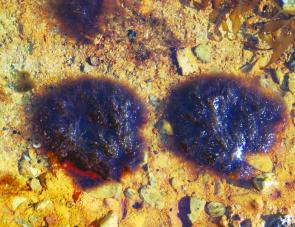

The author with an average ocean-run blackfish. Although they can be tricky at times, blackfish are one of the most abundant species found along our coastal rocks.

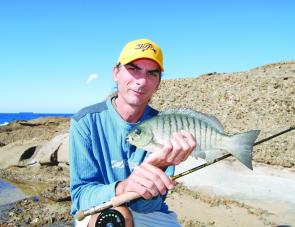
Fly fishing for blackfish off the rocks is a challenging technique but it’s also a whole lot of fun, especially for surface-feeding luderick.


Light threadline gear can also be used for blackfish off the rocks and is particularly effective when using baits like bread, peeled prawns or pink nippers. The fast retrieve speed makes line pickup a lot quicker, with more bites converted to hook-ups.
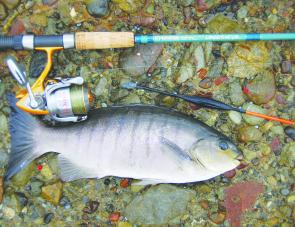

A typical blackfish spot will have plenty in the way of green weed or cabbage growth and some white wash close in around the rocks.
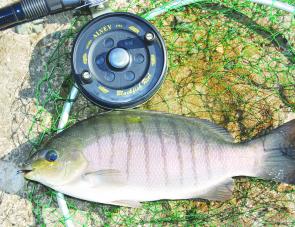
Alvey has a good range of dedicated blackfish reels. The 475A5E model is amazingly smooth running and has the sidecast function. It really is a brilliant reel to use off the rocks.
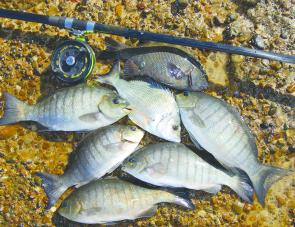
Bread baits work quite well for blackfish and also attract bream and drummer.

A selection of suitable stem floats and bobby floats. It pays to carry a few spares when fishing from the rocks because attrition can be quite high through snags and marauding drummer.

Thick green cabbage growth is a good indicator of where to look when seeking a spot o fish.

A small cabbage bait ready to go on a No 8 Mustad 4190 hook. Something about as big as your thumbnail is a good size. Blackfish don’t have huge mouths and suck in the bait.

Small white flies tied to look like pieces of floating bread work quite well when blackfish are in the right mood. Of course, a little bread berley helps attract the fish in the first place.

A variety of soft, dark brown weed grows on some rock ledges and if the fish are present, they won’t refuse this stuff.




